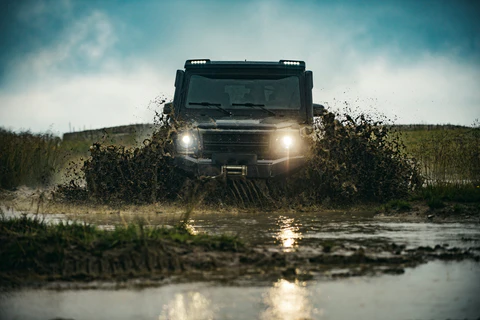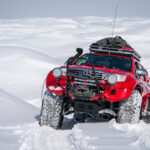Adventure seekers often encounter two terms that seem similar but have distinct meanings: overlanding and off-roading. Both involve vehicles, exploration, and outdoor experiences, but they cater to different purposes, skill sets, and lifestyles. Understanding the difference is crucial for planning your trip, selecting the right vehicle and gear, and maximizing both safety and enjoyment.
This guide will break down the key differences between overlanding and off-roading, provide insights into essential gear, highlight safety considerations, and offer tips for adventurers of all levels. Whether you’re a beginner or a seasoned explorer, this comprehensive resource will help you make informed decisions for your next adventure.
What is Overlanding?
Overlanding is defined as long-distance, self-reliant travel where the journey itself is the primary focus, rather than just reaching a destination. Overlanders combine exploration, camping, and adventure while being prepared for extended travel in remote areas.
The Overland Lifestyle
Overlanding is not just about driving; it embodies a lifestyle:
- Self-Reliance: Travelers carry all essential gear, including food, water, recovery tools, and camping equipment.
- Camping Focus: Frequent stops for camping allow adventurers to immerse themselves in nature and experience off-grid living.
- Planning and Navigation: Routes are carefully mapped, often spanning multiple countries or regions.
- Community: Overlanders often engage with fellow travelers, sharing knowledge, tips, and resources.
Secondary keywords like overland lifestyle vs off road and overland travel explained fit naturally here, emphasizing the lifestyle and philosophy behind overlanding.
What is Off-Roading?
Off-roading, on the other hand, focuses on driving through challenging terrains and technical obstacles, often for recreational purposes. It is characterized by short-term trips, adrenaline-driven activities, and skill-based vehicle navigation.
The Off-Roading Experience
Key aspects of off-roading include:
- Thrill and Challenge: Drivers tackle mud, sand, rocks, and steep inclines for excitement and skill testing.
- Vehicle-Centric: The activity emphasizes vehicle performance, suspension, tires, and other modifications.
- Shorter Trips: Off-roading typically involves day trips, weekend excursions, or trail events rather than extended journeys.
- Community Events: Many off-roaders participate in clubs, competitions, or guided trail rides.
Secondary keywords like overland adventure vs off road trails and overland vs off road camping highlight the recreational focus of off-roading.
Key Differences Between Overlanding and Off-Roading
Understanding the distinctions helps adventurers choose the right approach for their goals.
Purpose and Focus
| Feature | Overlanding | Off-Roading |
|---|---|---|
| Primary Focus | The journey, exploration, and experience | Technical driving and terrain challenges |
| Activities | Camping, sightseeing, cultural experiences | Trail navigation, obstacle courses, speed and skill tests |
| Mindset | Adventure and self-reliance | Thrill and vehicle mastery |
Duration and Distance
- Overlanding: Multi-day, weeks-long, or even months-long journeys covering hundreds or thousands of kilometers.
- Off-Roading: Typically shorter excursions; may last a few hours or a couple of days.
Vehicle Setup and Gear
Overlanding Vehicles: Equipped for comfort and self-sufficiency. Essential gear includes:
- Rooftop tents (internal link: Rooftop Tent Guide)
- Sleeping systems
- Cooking equipment
- Navigation tools
- Recovery gear
Off-Roading Vehicles: Focused on performance and durability:
- Upgraded suspension
- Specialized off-road tires
- Skid plates and armor
- Winches and recovery straps
Camping and Lifestyle
- Overlanding: Extended camping is integral; travelers often sleep in tents, rooftop tents, or portable shelters at scenic locations.
- Off-Roading: Camping is secondary; trips may include short stops or base camp setups, with primary focus on trail completion.
Terrain and Skills Required
- Overlanding: Moderate terrain; a range of driving skills is sufficient, but preparation and planning are crucial.
- Off-Roading: Extreme terrain; advanced driving skills are required to navigate obstacles safely.
Choosing Between Overlanding and Off-Roading
The choice depends on adventure goals, time availability, skill level, vehicle capability, and budget:
- Adventure Goals: If your priority is long-term exploration and immersion, overlanding is ideal. For thrill-seekers and technical driving challenges, off-roading is preferred.
- Time: Overlanding requires extended trips; off-roading can fit into weekends or short excursions.
- Skill Level: Overlanding suits beginners to experts with proper preparation; off-roading requires higher technical driving proficiency.
- Vehicle and Budget: Overlanding vehicles prioritize comfort and gear storage, while off-roading vehicles require performance upgrades.
Hybrid trips combining both styles are possible, offering extended travel with challenging off-road segments.
Essential Gear for Overlanding vs Off-Roading
Proper gear enhances safety, comfort, and enjoyment for both activities.
Overlanding Gear
- Rooftop Tents: Provide elevated sleeping arrangements and quick setup.
- Sleeping Systems: Sleeping bags, pads, and pillows for comfort in remote locations.
- Cooking Gear: Portable stoves, cookware, and utensils for meal preparation.
- Navigation Tools: GPS, maps, and compasses for remote travel.
- Recovery Kits: Tow straps, traction boards, and winches for self-recovery.
Secondary keywords: overland vs off road camping.
Off-Roading Gear
- Vehicle Enhancements: Suspension, off-road tires, skid plates, and roll cages.
- Safety Equipment: Helmets, gloves, and harnesses for extreme trails.
- Recovery Tools: Winches, jacks, and recovery straps.
Shared Gear
- First aid kits
- Communication devices
- Water and fuel storage
- Basic tools
Safety Considerations
Safety is paramount for both overlanding and off-roading. Key aspects include:
- Planning: Research routes, weather conditions, and local regulations.
- Vehicle Maintenance: Check tires, brakes, fluids, and recovery equipment before departure.
- Emergency Preparedness: Carry first aid kits, communication devices, and backup supplies.
- Skill Development: Practice driving techniques for your chosen activity.
- Environmental Awareness: Respect wildlife and natural habitats.
FAQs About Overlanding and Off-Roading
1. What is the main difference between overlanding and off-roading?
Overlanding focuses on long-distance travel, self-reliance, and camping, while off-roading emphasizes technical driving and challenging terrain.
2. Can you combine overlanding and off-roading in one trip?
Yes. Many adventurers incorporate off-road trails into longer overland journeys for variety and challenge.
3. Which is better for beginners: overlanding or off-roading?
Overlanding is generally more beginner-friendly if proper planning and preparation are done, whereas off-roading requires advanced driving skills.
4. Do you need a special vehicle for overlanding vs off-roading?
Overlanding vehicles prioritize storage, comfort, and reliability, while off-roading vehicles focus on performance and durability enhancements.
5. Are rooftop tents necessary for overlanding?
They are not mandatory but highly recommended for comfort, convenience, and safety. Internal link: Rooftop Tent Guide.
Conclusion & Call to Action
Overlanding and off-roading each offer unique experiences tailored to different adventure styles. Understanding their distinctions helps you choose the right approach, prepare the proper gear, and ensure a safe and enjoyable journey.
For those seeking long-term exploration with immersive camping, overlanding is ideal. For adrenaline-driven technical driving challenges, off-roading offers unmatched excitement. Hybrid trips combining both approaches are also possible for those seeking the best of both worlds.
Invest in reliable gear, plan your route carefully, and embrace the adventure. Explore overlanding gear options and check out our Rooftop Tent Guide to enhance your next overland journey.








